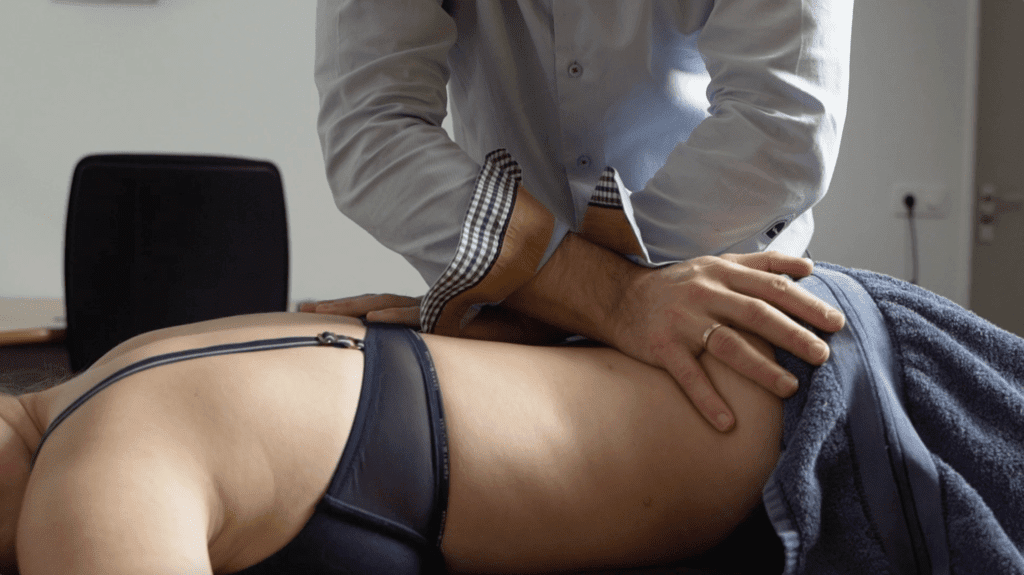Physiotherapy
IMC Gimborn » Therapies » Physiotherapy
Sometimes movement does not come naturally. Your body is sore or doesn’t work (anymore) the way you’re used to. Physical therapy prevents, remedies and reduces physical complaints and ensures that you can (continue to) move optimally.

When do you see a physical therapist?
- If you have injuries or pain, such as in your arms, legs, shoulders or back.
- Because of a (chronic) condition and need medical guidance in recovery.
- If you need to rehabilitate after surgery or an accident or build up fitness before surgery.
Physical therapy allows you to recover faster and move (or continue to move) as much as possible. With most complaints, you can see a general physical therapist who is trained to diagnose properly. For specific complaints, there are specialized physical therapists, such as a manual therapist. When the physical therapist is in doubt, he or she refers you to a (family) physician.
What does the physical therapist do?
The physical therapist is the expert in posture and movement. He or she will help you prevent, remedy or reduce your physical symptoms and ensure that you can regain optimal exercise. Therapy consists of treatment and counseling. For example, tips on your posture or exercises for at home.
The first appointment
At the first appointment, the physical therapist wants to know exactly what your physical symptoms are. That way, he can determine whether you will benefit from physical therapy or should see your doctor first. There will be an intake interview with a physical examination and treatment will begin.
Research
If it is clear that physical therapy can help you, you will work with the physical therapist to find the possible causes of your symptoms. He or she also examines the part of the body you are suffering from, and looks at how your complaint or condition affects your posture and the way you move your body.
Physical therapy allows you to recover faster and move (or continue to move) as much as possible.
Treatment
Once the physical therapist has made a diagnosis, he or she will discuss the treatment plan with you. Physical therapy treatment fits your personal situation and focuses on the goal you want to achieve.
Referral not required for physical therapy
Do you have a condition, complaint or injury that a physical therapist may be able to help you with? In most cases, you won’t need to see your (primary) physician first. You can contact a physical therapist right away. If you have a condition on the “chronic list,” you do need a referral. You can find out if you need a referral from your primary care physician or medical specialist in your health insurance provider’s policy values. If in doubt, you can see your physical therapist for advice.

What falls under chronic?
There is a list compiled by the government that includes all conditions that fall under the heading of “chronic. For each condition, there is a time limit to this. Below are the most common chronic conditions:
- Stroke
- Rehabilitation after an (orthopedic) rehab such as a new hip or knee
- Hip or knee osteoarthritis
- Hernia
- COPD
Cost and reimbursement
If you are insured for physical therapy, manual therapy treatment is also covered. If you do not have supplemental health insurance or have already submitted treatment for this year, click here for current prices.
Frequently Asked Questions Physical Therapy
Physical therapy is a paramedic discipline that focuses on treating and preventing musculoskeletal complaints. Physical therapy can be used, for example, for muscle and joint pain, spinal complaints, rehabilitation after surgery or sports injuries.
Physical therapy is partially reimbursed under basic insurance, but the number of treatments reimbursed varies by insurer. In addition, you may have supplemental insurance for physical therapy, which will reimburse you for more treatments. It is wise to consult your health insurance company to see what reimbursements apply to your specific situation.
You may experience some post-treatment pain or sensitivity in the treated muscles or joints after a physical therapist’s treatment. This is normal and usually disappears within a few days.
Physical therapy can cause muscle pain in some cases, especially when intense exercise or manipulation of muscles and joints is involved. This is usually short-lived and can be relieved by applying heat or light exercise.
Physical therapy can be an effective treatment for many different musculoskeletal complaints, but it is not guaranteed to provide the best solution for all complaints. It is important to get a proper diagnosis of your symptoms and consult with your physical therapist about the best treatment methods for your particular situation.
No, physical therapy is directly accessible, so you can make an appointment with a physical therapist without a referral from a family doctor or other physician. The same goes for the other disciplines we have in house such as, manual therapy, osteopathy, cranio-sacral therapy and acupuncture.
We treat a variety of complaints. If a complaint cannot be handled with us we will work with you to find where it can. If you are unsure whether your complaint can be treated with us? If so, please contact us.
No, unfortunately physical therapy has not been in basic insurance since 2012. However, there are some exceptions, which make you eligible for physical therapy from basic insurance. Examples include osteoarthritis of the hip and/or knee, Claudicatio Intermittens (arthritic legs). In addition, there are a number of chronic indications for which physical therapy is reimbursed from the basic insurance from the 21st treatment.
It depends on your insurance.
Physical therapy and manual therapy is not in the basic package, which means it must be reimbursed from your supplementary package. Wondering what your health care policy will cover? Then click here.
Osteopathy, cranio-sacral therapy and acupuncture are covered under alternative medicine reimbursements. For fees, click here.
No, physical therapy is paid from the supplementary package. Care paid for from the supplemental package is free of deductible. The exceptions are the treatments that are reimbursed by the basic insurance.
A treatment lasts 30 minutes, this includes dressing and undressing and making any new appointment.
The main difference between manual therapy and physical therapy is the hands. A manual therapist uses his or her hands to examine and heal the cause of your symptoms. So manual therapy is actually “hand therapy. Physical therapy can be called “hands-free therapy.
With a chronic condition, physical therapy treatments are reimbursed from the basic insurance from the 21st treatment. The first 20 treatments should either be covered by your supplementary insurance, or they are not (sufficiently) covered, you will be charged. Curious about your reimbursements?
Yes, physical therapy for children under the age of 18 is covered for the first 9 treatments, if necessary a request can be made for an additional 9 treatments. In addition, your children will have the same supplemental insurance as the parent whose children are on the insurance.
If you are unable to come to the practice due to physical symptoms, home physical therapy treatment is available. However, for home treatment, unlike treatment at the practice, a referral from the family doctor is required. This referral should then describe that the treatment should take place at home.
At the intake and anamnesis, your complaint is first assessed, and based on this, a physical examination is started in which the body part where the complaint is located is examined. Often it is helpful to have the body part you have symptoms on bare during the treatment, so we can get to it and see it clearly. We may therefore ask you to remove a piece of clothing.
Is your question not listed? Then get in touch.